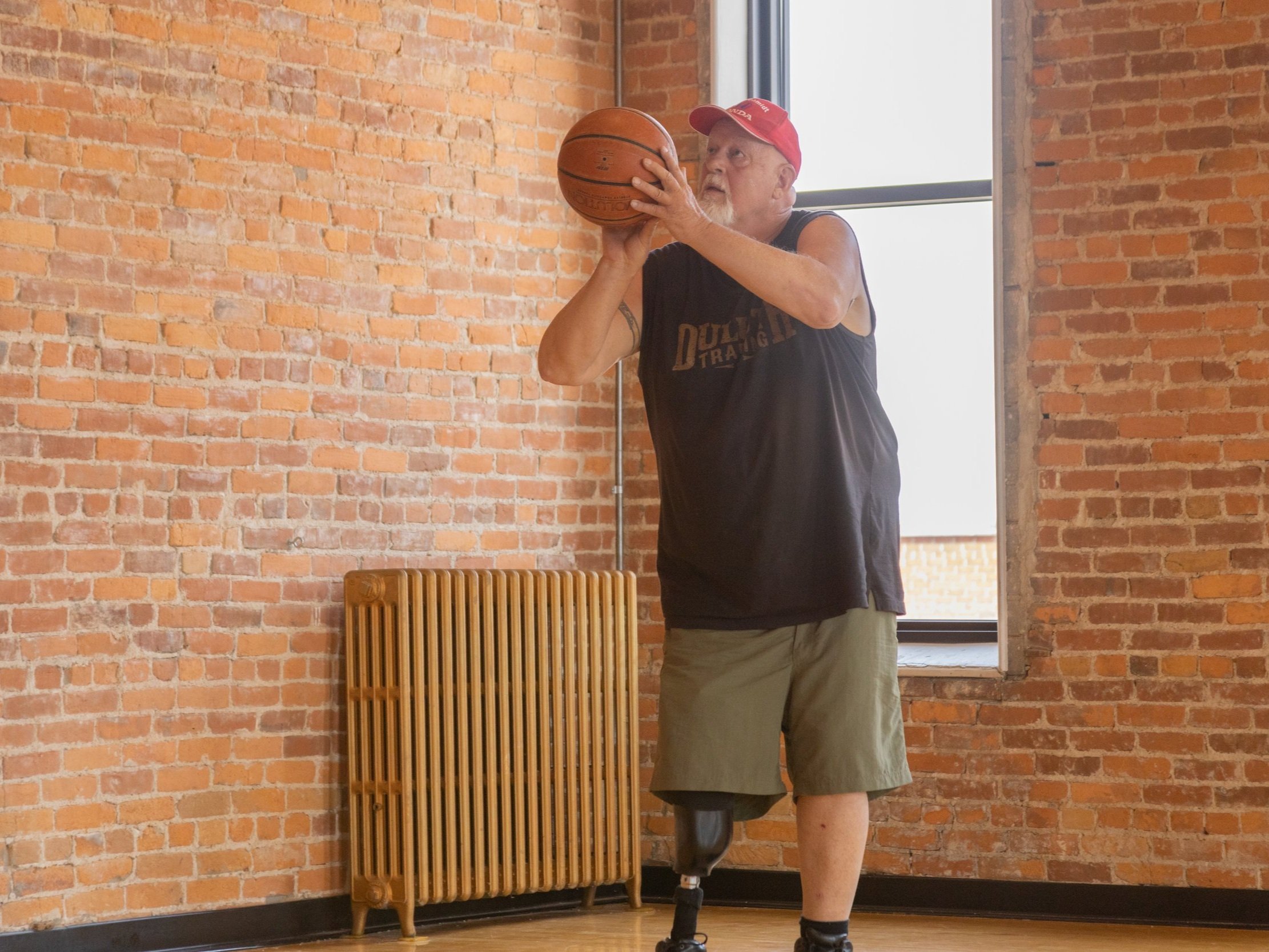Will I ever walk again?
Prosthetic expertise, determination help John Clark remain active
Story reprinted with permission from the Effingham & Teutopolis News Report.
Bryan King (left) the director of the Joint Active Systems Prosthetics & Orthotics Specialty CLinic, and John Clark have developed a great relationship. John contacted JAS following his operation that resulted in amputating his right leg below the knee. (Photo Steve Raymond / News Report)
John shows just how far he has come, showing his shooting skills with a basketball. (Photo JAS)
“Will I ever walk again?”
A valid question. Especially from someone that has had a portion of a leg amputated.
That was the exact situation John Clark was facing in September 2019.
He is an active, hard-working man that enjoys doing many things outdoors – from cutting wood to painting to gardening. But after having part of his right leg amputated – from approximately six inches below the knee – he was afraid he would never be able to do those things again.
Fast forward 31⁄2 years and all those fears have been removed.
“I can basically do everything I did before,” John said with a big smile. “I just do them a little slower.”
John, now 68 years old, has lived in rural Teutopolis his entire life. He played basketball and baseball for the Wooden Shoes and graduated from THS in 1973. He and his wife, Kathleen, have one daughter, Nicholle, who is a nurse in Champaign. John worked in highway maintenance for 31 years for the State of Illinois. He was diagnosed with Type 2 diabetes when he was in his early 50’s.
“I developed sores on my right foot and couldn’t get them to heal,” John explained. “We tried antibiotics and probably had 10 to 12 surgeries in about 12 years. But no matter what we did, the sores always came back.”
Ultimately, the infection spread into John’s ankle.
“It turned my foot red,” John said. “At first, they thought it might be gout. But it wasn’t. They told me I had to lose part of my leg. I had no choice.”
John admitted he was scared.
“I wondered if I’d ever walk again,” he recalled. “Plus, I worried about how well I would do with a prosthetic leg.” The operation, which was done at St. John’s Hospital in Springfield, went fine. But his first experience for prosthetics was not a good one.
“The first place I went was not really helpful,” John said. “When I was at Lakeland Nursing Home for rehab, I began to wonder if I was ever going to get a leg. I got depressed.”
Fortunately, John then reached out to Joint Active Systems (JAS). It was then he was introduced to Bryan King and everything began to change.
“I was so lucky to find Bryan,” John noted. “He was a game changer. He saved my life.”
Bryan King makes adjustments to John CLark’s new socket to help make the prosthetic leg align properly for walking. (Photo Steve Raymond / News Report)
King, CPO, LOP, is a certified orthotist and prosthetist and the director of the JAS Prosthetics & Orthotics Specialty Clinic. He has more than 30 years of experience and has been at JAS for the past five years.
“We have so many talented resources here, it allows me to be more creative and detailed in what we can offer our patients,” Bryan said. “Being connected to JAS provides a great opportunity. It’s what brought me here. These are the best people I’ve ever worked with.”
John was frustrated when he first started meeting with Bryan, but he was also determined. He wanted a prosthesis and he wanted to be active again.
“We did counseling and education with John,” Bryan recalled. “We went over every detail from the pre-prosthetic phase through rehabilitation. Generally, people that have their leg amputated below the knee do really well. Above the knee is much harder.
“John was extraordinary,” Bryan added. “He wanted to be very active and was committed to the entire process.”
A test was given to determine what type of “foot” he would receive for the prosthesis.
“The type of foot we make is based on what the individual wants to do,” Bryan explained. “Because John likes to work outside so much, he needed something that would support higher activity. Plus, we make them to support the body size and weight of the individual.”
John is 6’7” and weighs approximately 300 pounds. Bryan, along with the technicians at JAS, designed and custom-made a prosthetic socket that would fit John’s limb.
“We make a mold of the residual limb once it is healed and properly shaped,” Bryan said. “There are usually at least two test fittings. We work to make sure the alignment is set correctly. That’s very important due to the mechanics of walking. With our modular systems, we can make any adjustments necessary.”
“You have to be able to distribute the pressure evenly,” John added. “It’s easy to tell if it doesn’t fit right. If it doesn’t, you want that.”
“After an amputation, the limb will get smaller over time,” Bryan continued. “It will become loose and the individual will need to use socks to keep the prosthetic socket tight. Eventually, you’ll need to replace the socket.”
John is on his fourth socket, but Bryan noted, “He’s at a point he probably won’t need many more. The limb is probably about as small as it’s going to get.”
Then the rehab process begins – and it’s not easy.
“It was unbelievable,” John recalled. “When I first got the leg, I couldn’t even stand up on my own. And if I fell down, I couldn’t get up on my own. Then I didn’t know if I’d be able to walk without using a cane. Now, as long as I have something to hold onto, I can get up just fine. They taught me all that in physical therapy.”
“The physical therapy component is an important part of this process,” Bryan said. “You have to commit to it and John did.”
John was in physical therapy for three weeks. He went from using a walker to a cane to not requiring any assistance device whatsoever.
“I didn’t get frustrated,” he recalled. “I just kept going.
“You have to make sure where you step,” he quickly added. “Going up and down steps is easy. It’s more difficult in the wooded areas around branches and vines. You just have to make sure you don’t get hung up on anything. If not, that’s when you fall.”
Today, John is as active as he’s ever been. He’s cutting wood, painting his house and enjoying his garden once again.
“He is a great example of somebody getting their life back,” Bryan said. “For us, being a part of that is very rewarding. It’s not just about making the prosthesis. It’s about being part of the entire process.
“John had a great attitude, which is huge,” Bryan added. “Sometimes, that transformation can be difficult. For most, it’s harder than they anticipate. You really have to have motivation and drive.
“John worked very hard. When you see him walk now, you’d never know he’s an amputee.”



